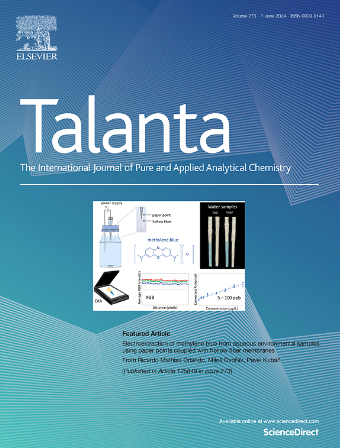High-sensitivity flexible electrochemical sensor for real-time multi-analyte sweat analysis
IF 5.6
1区 化学
Q1 CHEMISTRY, ANALYTICAL
引用次数: 0
Abstract
Flexible sweat sensors play a crucial role in health monitoring and disease prevention by enabling real-time, non-invasive assessment of human physiological conditions. Sweat contains a variety of biomarkers, offering valuable insights into an individual's health status. In this study, we developed an advanced flexible electrochemical sensor featuring reduced graphene oxide (rGO)-based electrodes, modified with a composite material comprising nitrogen and sulfur co-doped holey graphene (HG) and MXene, with in-situ-grown TiO2 nanoparticles on the MXene. The sensor design leverages the synergistic properties of its components: MXene provides a conductive scaffold, TiO2 enhances electrocatalytic activity, and the porous HG network facilitates efficient ion and electron transfer, with doping increasing the number of active sites. This configuration enables sensitive and simultaneous detection of ascorbic acid (AA), uric acid (UA), and dopamine (DA). Additionally, a potassium-selective (K⁺) film applied to rGO-enhanced electrodes supports concurrent detection of K⁺ in sweat. The sensor array demonstrates a broad detection range, low detection limits, and high sensitivity, while maintaining mechanical flexibility, anti-interference capabilities, and repeatability. Validated through in-situ sweat biomarker detection during exercise, the sensor effectively tracked fluctuations in K⁺, AA, and UA levels in a volunteer. This practical application underscores the sensor's potential for continuous health monitoring, and early disease detection, establishing it as a promising tool in modern healthcare.

求助全文
约1分钟内获得全文
求助全文
来源期刊

Talanta
化学-分析化学
CiteScore
12.30
自引率
4.90%
发文量
861
审稿时长
29 days
期刊介绍:
Talanta provides a forum for the publication of original research papers, short communications, and critical reviews in all branches of pure and applied analytical chemistry. Papers are evaluated based on established guidelines, including the fundamental nature of the study, scientific novelty, substantial improvement or advantage over existing technology or methods, and demonstrated analytical applicability. Original research papers on fundamental studies, and on novel sensor and instrumentation developments, are encouraged. Novel or improved applications in areas such as clinical and biological chemistry, environmental analysis, geochemistry, materials science and engineering, and analytical platforms for omics development are welcome.
Analytical performance of methods should be determined, including interference and matrix effects, and methods should be validated by comparison with a standard method, or analysis of a certified reference material. Simple spiking recoveries may not be sufficient. The developed method should especially comprise information on selectivity, sensitivity, detection limits, accuracy, and reliability. However, applying official validation or robustness studies to a routine method or technique does not necessarily constitute novelty. Proper statistical treatment of the data should be provided. Relevant literature should be cited, including related publications by the authors, and authors should discuss how their proposed methodology compares with previously reported methods.
 求助内容:
求助内容: 应助结果提醒方式:
应助结果提醒方式:


